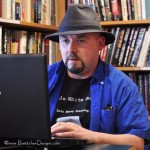A guest post by Doug Dandridge.
I mostly write military science fiction, and am writing military fantasy when not working on the next scifi novel. Exodus: Empires at War is a series with very detailed and lengthy battle scenes told from multiple viewpoints. I originally learned the main technique I used from reading the Dritzz DoUrden novels by R. A. Salvatore. If you’re not familiar with these wonderful stories, they involve a Dark Elf who has turned his back on his evil people and now fights the darkness with his mighty companions. There are very detailed battles in which maneuvers great and small are described, and often the companions find themselves fighting out of sight of each other. Not only are their battles told from their viewpoints, but the point of view of their major enemies. In my own battles, which can last for as many as eight chapters, you get the points of view of characters at different areas of the fight, on the different departments of the ships, even from both sides of the battle. I even switch back and forth from battles going on simultaneously hundreds of light years apart. Some people might find this a bit confusing, but my fans, military science fiction aficionados all, write rave reviews about the amount of detail.
I have seen writers who do their battle scenes from a single viewpoint, and they read like an endless description of the good guys fighting an unknown, a faceless enemy that could be anything. They go on and on with description after description, interspersed with dialogue, until the writer has to get to the climax or totally lose his readers, in most cases much too soon. I like to use a movie approach that switches back and forth and gives play to both sides. For example, think of The Wrath of Khan. First scene is Kirk watching the Reliant approach without establishing communications. The scenes switch back and forth to Khan ordering shields raised, Spock telling Kirk; Khan ordering locking on phasers, Spock telling Kirk; Khan yelling fire. Switch to the scene of phasers hitting the Enterprise, then a shot of the panic in engineering as everything goes to hell. Then back up to the bridge. The action comes in bursts from different points of view, including the omniscient one of the Reliant blasting the Enterprise.
Of course, Hollywood likes to show these kind of scenes in a manner that puts both combatants front and center, even if there are a whole bunch of them. Witness the final two episodes of Deep Space Nine, where there were over a thousand ships, and the screen was crowded with them. Something to do with wanting to awe the audience. In my novels battles are fought at long range, beam weapons almost useless until units get within a light minute of each other. Even at that range it takes time for a weapon to hit, and even ships two kilometers in length would appear tiny if on the same screen. In a book, the screen is the mind, and as long as you can convince the reader of that immensity, they will see it. But even here Hollywood gives an example when they want to. The movie Midway showed the battle between American and Japanese carrier forces, a fight where the ships didn’t see each other, but launched aircraft to do the actual attack. But with judicious switching of viewpoints they conveyed this type of fight perfectly. And it’s much easier to do in a book.
Doing each chapter as a series of mini-scenes in this way makes almost every scene a cliff hanger. Each installment ends with an unknown. Missiles coming in, lasers burning through the hull and klaxons sounding, the characters on the edge of disaster. The next scene does the same to someone else, on some other ship, then to the enemy, who is having problems of their own. Interspersed are scenes of small victories, and, as the fight progresses, much larger ones. After a sequence covering one part of the fight I like to change to a different area of the battle, maybe even a different star system, for the next. In this way I move the reader through an epic battleground where they are carried from tension to tension, with some small resolutions along the way.
To me the worst way to resolve a battle is with a non-event. I have read a lot of books where they build up to the fight, the training, the organization, the hopes and dreams of those involved. And in the next scene, it’s all aftermath. I feel ripped off by those stories. People read books that promise action because they want to read about that action. I provide that action. The first book of my Exodus series, more of a Universe establishment tale, had limited action, maybe twenty to thirty percent, and that is the worst reviewed of the series. After that, the action increases, until the later books have almost eighty percent action sequences. Some people may think that too much, preferring more time for character development or background. The thing is, I am working as a full time author by writing such, and success proves to me, at least, that the method works.

Doug Dandridge is a Florida native, Army veteran and ex-professional college student who spent way too much time in the halls of academia. He has worked as a psychotherapist, drug counselor, and, most recently, for the Florida Department of Children and Families. An early reader of Heinlein, Howard, Moorcock and Asimov, he has always had a love for the fantastic in books ad movies. Doug started submitting science fiction and fantasy in 1997 and collected over four hundred rejection letters. In December of 2011 he put up his first self-publishing efforts online. Since then he had sold over 100,000 copies of his work, and has ranked in the top five on Amazon Space Opera and Military Science Fiction multiple times. He quit his day job in March 2013, and has since made a successful career as a self-published author.


